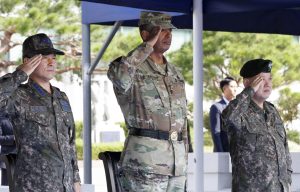After a three-day negotiation in Washington, South Korea and the United States have finally concluded their Special Measures Agreement (SMA) talks, according to a statement by South Korea’s Foreign Ministry on March 8. The SMA negotiations – which cover South Korea’s contribution to the cost of U.S. Forces Korea (USFK) – had been deadlocked since last year, allowing the previous agreement expired with no replacement.
The SMA negotiations had stalled due to former U.S. President Donald Trump’s unilateral demand for South Korea to increase its monetary contribution up to five times the cost agreed in 2019. Now that the two countries have finally settled the important negotiations, it is expected to serve as great momentum and an opportunity for the restoration of the alliance.
South Korea’s Ministry of Foreign Affairs released a press release saying the two sides reached a principled agreement as a result of the SMA negotiations between Seoul and Washington last week. The two countries will announce the results of negotiations in more detail and sign a preliminary statement after finalizing the internal report process. The Foreign Ministry also stressed that Seoul will contribute to the strengthening of the U.S.-ROK alliance and joint defense posture by signing the agreement as soon as possible.
A U.S. State Department spokesperson also told the Wall Street Journal that the two countries have reached agreement on SMA negotiations and said the agreement included “a meaningful increase” from Seoul. The spokesperson said the agreement shows the Biden administration’s “commitment to reinvigorating and modernizing our democratic alliances around the world.”
Neither the Foreign Ministry nor the State Department gave details about the agreement, including the rate of increase in defense cost and term of the agreement. The Wall Street Journal, however, reported that the new agreement will be valid until 2025, while Reuters reported that the agreement will be a six-year agreement. News outlets have mostly cited anonymous sources in the either Foreign Ministry or State Department with official statements limited as of this writing.
The SMA agreements had previously been revisited every five years up until 2018, when the Trump administration pushed for yearly renegotiations. Seoul wanted and expected to reach a long-term deal again to maintain a stable alliance and safeguard the security of the Korean Peninsula. As Trump had used the yearly negotiations to demand sharp increases in Seoul’s defense contributions, many experts have said that signing a one-year term does not benefit South Korea’s national interest.
According to local media reports, Seoul and Washington are scheduling a two-day visit to South Korea by U.S. Secretary of State Antony Blinken and Defense Secretary Lloyd Austin from March 15 to March 17. An official announcement of the SMA is likely to be made during their visit.
Last week, Seoul’s SMA negotiator Chung Eun-bo visited Washington to negotiate with his U.S. counterpart, Donna Welton. The negotiation was originally scheduled to last two days, but as negotiations stretched into a third day experts observed that they may have entered last-minute coordination to reach a deal.
Since President Joe Biden took office in January, Washington has taken relatively fast steps to revive the stalled SMA negotiations in order to restore the importance of the U.S.-ROK alliance. South Korea and the United States held their eighth SMA meeting virtually on February 5, shortly after the inauguration of the Biden administration; last week’s meeting was the first in-person meeting they had held since a meeting in Los Angeles in March 2020. In Los Angeles, negotiators tentatively agreed to raise Seoul’s annual contribution by 13 percent, reaching $1.2 billion, but the two sides failed to sign the agreement due to Trump’s demand for contributions to soar up to $5 billion.
The breakdown in talks led to real-world consequences, as approximately 45 percent of Korean employees working for the USFK had to be furloughed due to the failure to reach an agreement last year. Without an agreement in place, the South Korean government and National Assembly had to come together to pay the workers temporarily by enacting a new law and issuing executive orders.
However, now that the two sides have reached an agreement, some public and national experts are worried about the cost that Seoul is going to pay for U.S. troops stationed in South Korea. Critics say the amount Seoul pays has already increased roughly 40 percent in the past decade, and many argue that it would be more beneficial to invest that money in strengthening the national armed forces instead. South Korea paid around $690 million in 2009 for defense cost-sharing and now it is expected to pay around $1.2 billion a year under the new deal.
“Raising the defense cost by 13 percent will be a higher rate than the amount of increase in the previous negotiations,” Kim Hyun-wook, a professor at the Korean National Diplomatic Academy, told The Diplomat. “I think Seoul had called for a lower rate than 13 percent in the recent negotiations, but it could not have worked due to its original offer – a 13 percent increase – to the Trump administration.” Kim added that it was impossible to reach an agreement last year on the extent of the increase due to Trump’s “America First” approach.
The agreements between Seoul and Washington must be ratified by the South Korean National Assembly after being officially signed. Experts predict that the SMA will be finalized by the end of March.
































